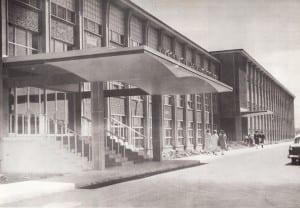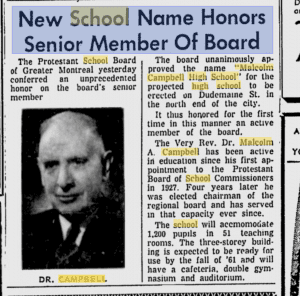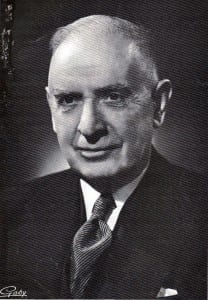Biographical sketch of the Very Rev. Dr. Malcolm A. Campbell, after whom Malcolm Campbell High School is named
June 20, 2019
I recently asked Graeme Decarie, who taught history at Malcolm Campbell High School in the early 1960s before going back to school for his Master’s and Ph.D. in history and a subsequent (and celebrated) career teaching history at Concordia University, to share a quick biographical sketch highlighting the career of Malcolm Campbell.
As well as teaching at Concordia, Dr. Decarie also worked as a commentator with CBC and CJAD for many years.
Dr. Decarie was a close observer on an occasion in the early 1960s when Dr. Campbell visited the MCHS school office (the female staff at the office quickly becoming, as I have learned from Dr. Decarie in email conversations over the years, unpleasantly aware of his presence) and subsequently gave a rousing, well-received speech to an assembly of students and staff.

Mark Melkonian (MCHS 1970) and Cheryl (Miles) Goldring (MCHS 1967) sing the MCHS school song. I’ve chosen to highlight this photo because it serves so well, to remind us of the joy that is at the heart of a high school reunion such as the one that took place on Oct. 17, 2015 at Old Mill Toronto. Walter Psotka photo
Those of us who attended Malcolm Campbell High School, as I did in the early 1960s, know a lot about Malcolm Campbell, the high school, but may know a little less about the Very Rev. Dr. Malcolm A. Campbell, after whom the school is named.
I did not know much about Malcolm Campbell, as an individual, but over time I have gathered a few details, here and there.
Having made a few presentations about local history over the years, I have learned it’s good to add a few judicious, evidence-based tidbits of information, here and there, as I have done at the current post, to ensure the full attention of the audience. Otherwise, people start to fall asleep.
School song
I will begin by referring to a previous post entitled:
With Pride We Wear the Scarlet and the Silver – Recorded at MCHS Reunion (2000)
At the latter post, you can get access to a recording – courtesy of Tim Hewlings (MCHS 1963) – of the MCHS school song, which refers to Malcolm Campbell as the school’s Patron, whom “we take as our example.”
An additional post of interest is entitled:
Comment from Steve Lesser (MCHS ’73) regarding “The Scarlet and the Silver”
At that post, Steve Lesser (MCHS 1973) notes that the version of “The Scarlet and the Silver” recorded in 2000 “is actually not the original version of the song. According to Mr. Smith, who was a great mentor to me, the original ‘sounded like a dirge.’ He told me that he changed the tempo and the tune to make it sound more upbeat.”
March 1959 Montreal Gazette article
A March 25, 1959 Montreal Gazette article is entitled: “New School Name Honors Senior Member Of Board.”
The article (I have kept the American spelling intact and have corrected one typo) reads:
The Protestant School Board of Greater Montreal yesterday conferred an unprecedented honor on the board’s senior member.
The board unanimously approved the name “Malcolm Campbell High School” for the projected high school to be erected on Dudemaine St. in the north end of the city.
It thus honored for the first time in this manner an active member of the board.
The Very Rev. Dr. Malcolm A. Campbell has been active in education since his first appointment to the Protestant Board of School Commissioners in 1927. Four years later he was elected chairman of the regional board and has served in that capacity ever since.
The school will accommodate 1,200 pupils in the 51 teaching rooms. The three-storey building is expected to be ready for use by the fall of ’61 and will have a cafeteria, double gymnasium and auditorium.
[End]
As well, a previous post, featuring the dramatic low key lighting which was a trademark of a photographer named Gaby, is entitled:
Portrait by Gaby of Malcolm A. Campbell features dramatic low key lighting
Brief biographical sketch, courtesy of Graeme Decarie
Dr. Decarie, who now lives in Ottawa, has shared the following biographical sketch regarding Malcolm Campbell, the school board official after whom Malcolm Campbell High School was named:
Reverend Malcolm Campbell was from a Presbyterian church in Montreal that stood at the north end of Fletcher’s Field. That, about the 1890s, had become part of the home ground of wealthy anglos.
(Earlier, they had settled in what is now the business district of Notre Dame. But by World War 1 and even earlier, they were more likely to be found along St. Catherine and Sherbrooke and above – and down to Windsor Station. You can still see their very well preserved homes.)
And the churches were highly regarded. At the corner of St. Catherine and University is an Anglican Church (Christ Church) whose ministry included the virtues of playing golf. The minister of that church founded The Royal Montreal Golf Club in 1873. It was the first golf club in all of North America. Nor was it unusual for a clergyman to see golf as a part of his ministry. Golf was a recreation to raise the spiritual level of the congregation. It was common for some games to be seen as spiritual. Hockey, then being invented on Dorchester just a short walk West of Phillip’s Square, was in that category.
The games of the working class did not count as inspiring Christian virtues.
This area was the centre of English Montreal. The Molson family, for example, attended Christ Church – and from it they controlled a local regiment, The Grenadier Guards. But during World War 1, they would quarrel, and move themselves and their patronage to the Black Watch. And it, too, had a church – St. Andrew and St. Paul on Sherbrooke St. near the art gallery. I expect the Molsons also moved themselves to the Presbyterian church.
The rich English spread over McGill. And that’s how a baby named Christopher Plummer was born just above McGill. That brought him to Montreal High School just two years ahead of me. Montreal High School was the city’s prestige anglo school.
(It still had that prestige in my time when kids in my district were sent to MHS. Alas, I would not be one of the elite. The principal kicked me out in grade 11. To this day, I still don’t have a high school certificate. But I really wasn’t in the great, wealthy tradition of Plummer who used to be brought back to school after he graduated to perform in the annual Shakespeare play. I was just a north end kid.)
One of the keys to the social and civic power of the wealthy was their churches. So the minister often was a key figure in social issues – like sport, the art gallery, like education.
And one of those key figures was the minister at the Presbyterian church that stood (and still stands) at the north end of Fletcher’s Field. But it is no longer a church. By 1920, wealthy anglos were already several decades into moving west to Westmount, and relying on the train to get to work.
And, somewhere in that flitting time of a dying era, Reverend Malcolm Campbell was posted to that church. And, as was common at the time, the schools were seen essentially as religious institutions. And that’s why a young Malcolm Campbell was soon seen as chairman of the Montreal English Protestant School Board.
And that’s why I learned in grade 1 to become a socially modelled child. Every morning we saluted the union jack and chanted “I pledge allegiance to this flag, and the Empire for which it stands.” Then we said the Lord’s Prayer and sang a hymn. Every morning – because that’s what school was all about.
(The church sign on the building is no longer there, and the building is now apartments. But it still looks very much like a church. I was the speaker at its closing meeting. Alas, Reverend Campbell had died some years before.)
Was he a dynamic and exciting chairman? Well, no. Through his time the school board was, like all school boards, something to be kept quiet and conventional. Things are still much like that. Now dominated by business leaders, you have the same problem – people whose knowledge of the world and what it needs is pretty well limited by their social outlooks and by their lack of any knowledge of education. I found the same sort of thing when the Concordia Board of Governors was chaired by Eric Molson. That’s why school boards are weak in innovation – and why university boards are dominated by the ranks of zombie dead.
Oh – you wanted some dirt? Well, yeah. He was fond of whiskey – and had brought his own for the day at MCHS. He also goosed the secretary while waiting. (I think it’s recommended in the New Testament according to Presbyterians.)
And, oh, he could handle an an audience. He said nothing, really. But he had that high school audience eating out of his hands.
Graeme Decarie
[End]
“Our Patron’s life we take as our example”
In preparing this post, I’ve encountered a comment from an MCHS grad which reads:
Hmm re: our school song & goosing:
“Our Patron’s life we take as our example”
These days his ‘pinches’ may have led him to being a jailbird…quite an example to follow! LOL
[End]
I’m pleased that is has been noted that there is an aspect to the man’s life that is indeed “touching”!
Update
A subsequent post is entitled:




There were 8 buses that brought students from Montreal North, 8 miles West to St. Laurent to go to the brand new high school, Malcolm Campbell when it opened in 1961. Our high school choir, under the direction of Mr. Hopper, sang the school song at every assembly & graduation 🎓 We all got to meet & shake hands with Rev Malcolm Campbell. We were the first students to go from grade 8-11 & graduate. I was at the Millennial reunion in the year 2000 & was part of the group that got together to record the High School Song. I still remember all the words!! I now live in Calgary Alberta as even though I was bilingual it was difficult to find a job in Montreal. Calgary kept me working permanently for 20 years & gave me a bilingual allowance. I still work but part time & at home. Sue Fellows
Wonderful to read your recollections Sue! I recall reading that students were impressed that Rev. Malcolm Campbell made a point of shaking hands with all the students. The School Song remains so strongly in our minds, for so many of us.
It’s interesting how some MCHS grads have spread across Canada and around the globe in the years since graduation (while others have stayed firmly rooted in Montreal). I ended up going to university in British Columbia and lived out that way for seven years before eventually settling in Toronto (I now live in Stratford). I visited Calgary many times when I worked at the Banff Springs Hotel for three summers in the late 1960s. I’ve spent time in Calgary and in Edmonton on visits over many years since.
I very much like the fact that MCHS grads meet for luncheons and get togethers in places across North America. In my case, I regularly meet with fellow grads at Mandarin restaurants in Kitchener and Toronto.
I’m also pleased I’ve recently been able to help out in a small way, by way of information sharing and the like, in support of the MCHS 1969 50th Anniversary Reunion that is taking place over the weekend (three separate events, over three days) starting today (June 21, 2019) in Montreal. I’ve prepared the biography of Rev. Campbell, with help from Graeme Decarie, so that it can be shared at the latter event.
Some synonyms for flitting: fleeting, ephemeral, evanescent.
A Facebook comment (after we had posted the Rev. Malcolm Campbell article to an MCHS Facebook page):
“Great story by Mr. Decarie as always! very sobering and touching. lol.”
I would say there are many facets – some poignant, some not – to this story.
It is one story related to one (memorable) high school.
Each story, from whichever angle we view it from, is part of history and is a subset of the wider stories, within which high schools everywhere are embedded.
I am a graduate of MCHS from 1968 and in 2008 our class celebrated our 40th anniversary with a large gathering in Montreal. At the time I wrote this light hearted story about the founding of the school which you might enjoy,
Dave Simmons
The Founding of Malcolm Campbell High School, As I
Remember It.
by David Simmons.
The 1950’s was an Age of Speed. No, not the drug –
that age was to come a few years later – but of
automobiles which gave one a sense of mobility and
freedom.
People were crazy about their cars: large fins, giant
engines and autos the size of ocean liners were all
the rage. Racing car drivers such as Mario Andretti,
A.J. Foyt and Jim Clark were the heroes of the day.
Perhaps, therefore, it made some sense that the board
of governors of the Protestant School Board of Greater
Montreal was dominated by men who were avid racing
fans. From these car-crazed governors came the
proposal to start a school which would train young
people to become race car drivers. After a quick
debate by the board (the minutes were apparently lost
in a fire connected with the police and firefighters
strike in October 1969, see
http://en.wikipedia.org/wiki/Murray-Hill_riot ) it was
decided to open a school in the north of the city
named after Sir Malcolm Campbell, who was the world
land speed record holder. Also included in
the proposal was a plan to build a rather extensive
car racing track just to the east of the school.
Construction was started in the late 1950’s, with the
race track opening first, in early 1959. At this
point, political events in Quebec worked to force some
serious changes to the plans of the school board. As
you may recall, the “Quiet Revolution” was just
getting underway in the province and the Anglo
population of Quebec was just about to experience the
first wave of this change.
Soon after the race track was opened, it was
discovered that the track allowed easy access to the
ski hills north of the city. Up to that time, the
drive north was extremely long and difficult on the
old Route 15, over the ancient two-lane Cartierville
bridge. Mayor Drapeau saw an opportunity to gain the
votes of the largely French-speaking skiing population
of the city by seizing the race track and renaming it
the “Laurentian Autoroute”.
When the school opened in September 1959, it naturally
consisted largely of students who planned on become
racing car drivers. A riot occurred when the students
discovered that the track was closed to them and
therefore the school would have to adopt the regular
high school curriculum. In response, the city erected
a very high chain link fence on the east side of the
school, which can still be seen today as evidence of
the riot. Knowledge of this riot was blocked by the
government and has only recently become available
through the Freedom of Information Act. (see:
http://www.justice.gc.ca/en/ps/atip/ ).
I recall talking to a fellow student who, in 1964, was
still in grade 11. He’d been one of the original
students attracted to the school in hopes of becoming
a race car driver. He looked out the third floor
window at the autoroute in a wistful manner and
muttered that now he’d be forced to go to law or
medical school. Perhaps that political decision made
back in 1959 is partially responsible for all the bad
drivers who seem to plague Quebec today.
Wonderful to know about the MCHS 1968 Reunion in 2008, David. I’ve heard many good things about that graduating class, as I have heard about other classes down the years as well.
The link, for Sir Malcolm Campbell, that was included in your comment turned out not to be an active link. Links tend to come and go. A current link that provides an overview of his career is this one:
https://www.britannica.com/biography/Malcolm-Campbell
The photo on the right is from the above-noted link. Although the lighting is decidedly different, the general demeanour of the subject is closely aligned with the demeanour evident in the photo by Gaby, on the left, of the Very Rev. Dr. Malcolm A. Campbell.
They both demonstrate skill in knotting a tie.
I enjoyed reading your well-written, alternate-reality legend of how, in keeping with the well-documented legacy of the “other” Malcolm Campbell, the school got its name.
Before I approved your comment for posting, I spent a few moments checking online to ensure I knew how to spell the word “apocryphal” correctly!
Thanks for the updated link about the life of Sir Malcolm Campbell. When I originally sent out the story it generated many interesting responses such as the following (I edited out the name of the writer):
I was there the first day the school opened to
students in Sept 1960 (not ’59); there were no riots,
no fence, no talk of race tracks. And I remember
sitting in traffic at the Cartierville bridge for
hours on the drive back from the Laurentians, so the
Autoroute was welcomed by all. The idea of a racing
school run by the staid PSGM is a little far-fetched.
Dave